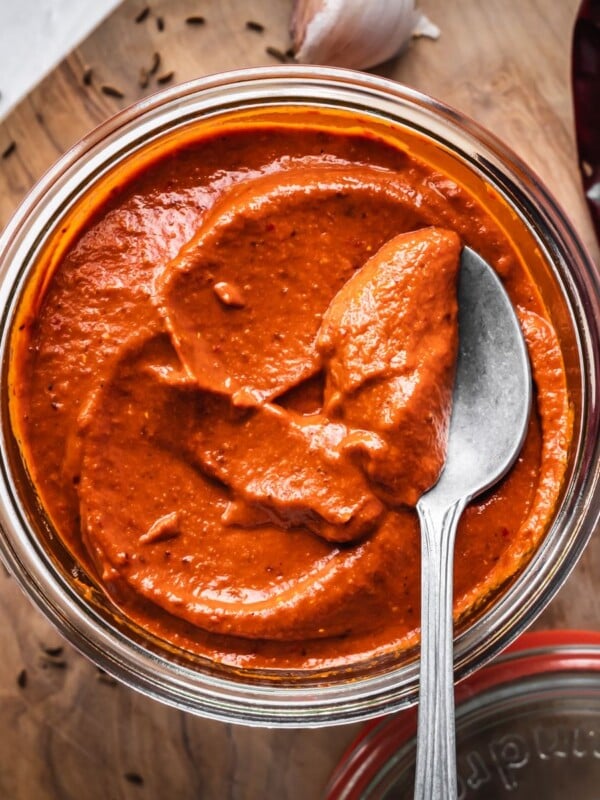Cilantro Chimichurri is an herbaceous, tangy, and spicy condiment that elevates grilled proteins, steamed seafood, roasted vegetables and even salads. It’s incredibly easy to make and comes together in under 15 minutes.

Why You’ll Love this Recipe
First and foremost, this is not a traditional chimichurri recipe. Traditional chimichurri includes flat-leaf parsley, olive oil, vinegar, garlic, hot peppers and salt and pepper. This recipe is more of an adaptation and an homage to the original.
This recipe is also quite similar to Colombian Ají, a popular condiment from the South American country that is served with empanadas and grilled chorizo. My partner’s Colombian Ají is featured in my book, Seed to Table.
- A burst of flavor: This recipe is herby, fresh, sour, and spicy, with bitter and sweet notes.
- Comes together quickly: This cilantro chimichurri will be ready in under 15 minutes.
- It is versatile: the sauce complements grilled meat, and grilled vegetables. It can be used as a marinade, and can be used as a base for a salad dressing. The possibilities are endless.
Ingredients
Easy-to-find ingredients make this a simple recipe for home cooks. Parsley and cilantro are available at most if not all grocery stores. The rest of the ingredients are pantry staples.

Cilantro vs Coriander
Depending on where you are in the world, you may call this herb: cilantro, coriander, or fresh coriander. The interesting thing about coriander and cilantro is that they are essentially from the same plant. Coriandrum sativum is the scientific name.
Coriander seeds are ground into coriander spice, a brown powder used across the globe and is the main ingredient in Middle Eastern 7-spice blend or South Asian garam masala.
When the seeds are planted, they will grow into what we know in North America as the cilantro plant. The green stalks and leaves of Coriandrum sativum are what we consume fresh as cilantro.
With so few ingredients in this recipe, there aren’t many substitutions you can make, but it is certainly possible to use what you have on hand.
- Herbs. This recipe uses both cilantro and parsley. However, you certainly use parsley or cilantro. If you only have parley on hand, I recommend my Authentic Hand Chopped Chimichurri Recipe instead. If you replace the cilantro with basil, you’ll end up with a sauce with a flavor profile that is more in line with Italian cuisine. Or for a fun twist, try my Red Chimichurri!
- Vinegar. You can get creative here. The recipe calls for red wine vinegar, which is a pretty standard type of vinegar most home cooks have in their pantries. However, you can certainly make this with white wine vinegar, champagne vinegar, white distilled vinegar or even lemon juice.
- Chili flakes. Heat levels are personal. Feel free to omit the chili flakes, or double the quantity if you like. You can also use fresh chilis.
- Oil. I recognize that some people might be watching their intake of fats. You can use less extra virgin olive oil in this recipe. Make sure to replace with a more suitable liquid, like vinegar or a splash of water. This will help keep the sauce nice and runny rather then chunky and dry.
See the recipe card for full information on ingredients and quantities.

How to Make this Recipe
This recipe will come together in no time. It’s as simple as combining all the ingredients in a small bowl, mixing well, tasting and adjusting the seasoning to your liking.

1. Wash and dry the herbs. You will want to make sure the herbs are as dry as possible before you start chopping (Image 1).
2. Chop. Finely chop the herbs and garlic and place them in a mixing bowl (Image 2).
3. Mix. Add the chili flakes, vinegar and olive oil. Stir to combine. Taste and season (Image 3).
4. Rest and serve. Allow the chimichurri to rest for 2 hours and then serve (Image 4).
Alternate Method (Food Processor)
I get it, sometimes we just don’t have the time to hand-chop every ingredient. That’s why modern conveniences like food processors exist.
If you choose to use a food processor, my recommendation is to follow this sequence so that you end up with the best possible sauce:
- In the food processor, add the garlic cloves and vinegar. Process until the garlic is finely minced.
- Add the herbs and chili flakes. Pulse until you have a coarse mixture.
- Add the extra virgin olive oil and pulse until you reach the desired consistency.
- Taste, season, and pulse again.
What to Serve This Cilantro Chimichurri With
As mentioned earlier, chimichurri is a condiment served with grilled meats. But don’t let that stop you from experimenting.
- Grilled or roasted vegetables. This sauce adds an incredible punch of flavor to grilled zucchini, eggplant and sweet peppers. Drizzle it over roasted cauliflower. Serve it at your next barbecue.
- Grilled proteins. traditionally chimichurri is served with grilled beef but nothing is stopping you from enjoying it with other proteins like chicken, lamb and pork. You can even serve it with grilled chicken kafta and beef kofta. Try it with my Pistachio Crusted Rack of Lamb.
- Slow roasted meat like my pulled lamb.
- Seafood. You can use this sauce to season a filet of fish before roasting or steaming. The sauce can be used as a dip for grilled or steamed shrimp.
- Tofu and meat substitutes. Treat this sauce as you would any other.
- Salad dressing. Thin it out with more oil and vinegar and you have a tasty salad dressing. Perfect for a hearty potato salad.

Expert Tips
This is an incredibly easy sauce to make and comes together in no time. These tips should give you the best results:
- Dry the herbs: If the parsley and cilantro are too wet after washing, the chimichurri could end up watery and lacking in flavor. Wash and spin dry the herbs (or let them air dry) before proceeding with the recipe.
- Hand chop the herbs: it will not take you much time to hand chop the cilantro and parsley. Hand chopping using a sharp knife will not bruise the herbs and cause them to oxidize and brown. I recommend hand chopping in my Mint Chimichurri Sauce Recipe too.
- In a pinch, you can use a food processor and pulse the herbs. Avoid running the food processor too long or else the heat generated from the motor and blade can affect the color of the herbs.
- Use quality ingredients: This recipe only includes a handful of ingredients. Use quality extra virgin olive oil and vinegar. Make sure your herbs are as fresh as possible.
- Use a glass or ceramic mixing bowl and jars: Because of the acid in this recipe, I recommend avoiding metal bowls or containers.
Recipe FAQs
Chimichurri is an herbaceous condiment, sauce, and/or marinade from Argentina. It is traditionally served with Asado (grilled meats).
Traditionally speaking, Argentinean chimichurri should not have cilantro in it. However, there are many recipes today that include cilantro alongside parsley.
No, chimichurri recipes call for fresh parsley. Dried parsley is not suitable for this sauce.
Yes. This sauce can be kept in the refrigerator for up to a week. However, it is best consumed within 48 hours as the cilantro and parsley will begin to brown in the fridge.
I recommend storing it in an airtight glass container like a mason jar or bottle.
More Delicious Sauces to Try
Condiments
Condiments
Preservation
Preservation
If you make this Cilantro Chimichurri or any other sauces and preserves on Urban Farm and Kitchen, please take a moment to rate the recipe ⭐⭐⭐⭐⭐ and leave a comment below. It’s such a help to others who want to try the recipe.
For more Urban Farm and Kitchen, follow along on Instagram, Facebook, and Pinterest, visit the Urban Farm Shop, or subscribe for new posts via email.
Cilantro Chimichurri

Ingredients
- ½ cup Cilantro – packed
- ½ cup Flat leaf parsley – packed
- 3 Garlic cloves
- ½ cup Extra virgin olive oil
- 3 tbsp Red wine vinegar
- 1 tsp Chili flakes – more or less to taste
- Salt and pepper to taste
- 1 tsp White sugar – Optional
Instructions
- Wash and dry the parsley and cilantro.
- Finely chop the herbs and garlic and place them in a mixing bowl.
- Add the olive oil, red wine vinegar and chili flakes. Stir to combine. Taste and season with salt and pepper. Optional, you can add a teaspoon of white sugar to balance the bitterness.
- Serve right away or allow the chimichurri to rest on the counter covered for up to 2 hours and then serve. Or refrigerate for up to 1 week.
Notes
Nutrition
Nutrition information is automatically calculated, so should only be used as an approximation.
 Like this recipe? Rate & comment below!
Like this recipe? Rate & comment below!














